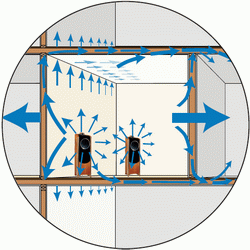Soundproofing Flanking Noise, Part 1
By
Ted White
Soundproofing Company, Inc.
What is Flanking Noise?
When we’re discussing a soundproofing issue with a customer, we generally spend quite a bit of time describing the phenomenon of flanking sound and its effects on soundproofing. This is at the heart of solving many noise problems.
So what exactly is Flanking Noise? Let’s imagine for a moment that you have a wave of water approaching your house. You run outside and install a sandbag wall that is exactly as wide as your property. No water should get through that wall. Next thing you notice that you are up your ankles in floodwater. Why? Because the water simply went around your wall. The water flanked your wall.
This is similar to what might be experienced in a soundproofing strategy. Suppose you share a common wall with a neighbor and he keeps you up at all hours. Perhaps you have an upstairs neighbor that sharpens his bowling skills after midnight. Let’s further suppose that for soundproofing you install 12” of lead on that wall or that ceiling. That should solve the problem, eh?
If you think of our floodwater analogy, it might not come as a surprise that you may continue to hear that noisy neighbor even after a soundproofing treatment. Like our floodwater, some of the sound simply flanked around the 12” of imaginary lead.
Sound will move from one room to another through both direct and indirect paths. Some amount of energy will travel through or around a wall or ceiling, as shown below.

Can You Apply Soundproofing Treatment to Noise Flanking Paths?
You might wonder if you should even bother with applying soundproofing to just the wall or just the ceiling at all. Well while every structure is different, soundproofing only the one main “direct” pathway will most often prove satisfactory for most people. This tactic generally reduces the sound to a tolerable level, but will usually not eliminate 100% of it.
It is important to understand that while sound can travel through air pockets like ductwork, stud and ceiling joist cavities, it can also be conducted along studs, joists, pipes, concrete and glass. Like your voice on a string between two orange juice cans. The string is a conductor just like a stud or joist.
A common myth is that if you don’t treat every surface, all of your soundproofing efforts will have been in vain. This is simply not the case at all. If you significantly reduce the sound passing through the one main wall by soundproofing, for example, that’s great. What remains will likely be flanking noise coming through side walls, the floor or some other surface not having a soundproofing treatment.
Click on Soundproofing to continue.






